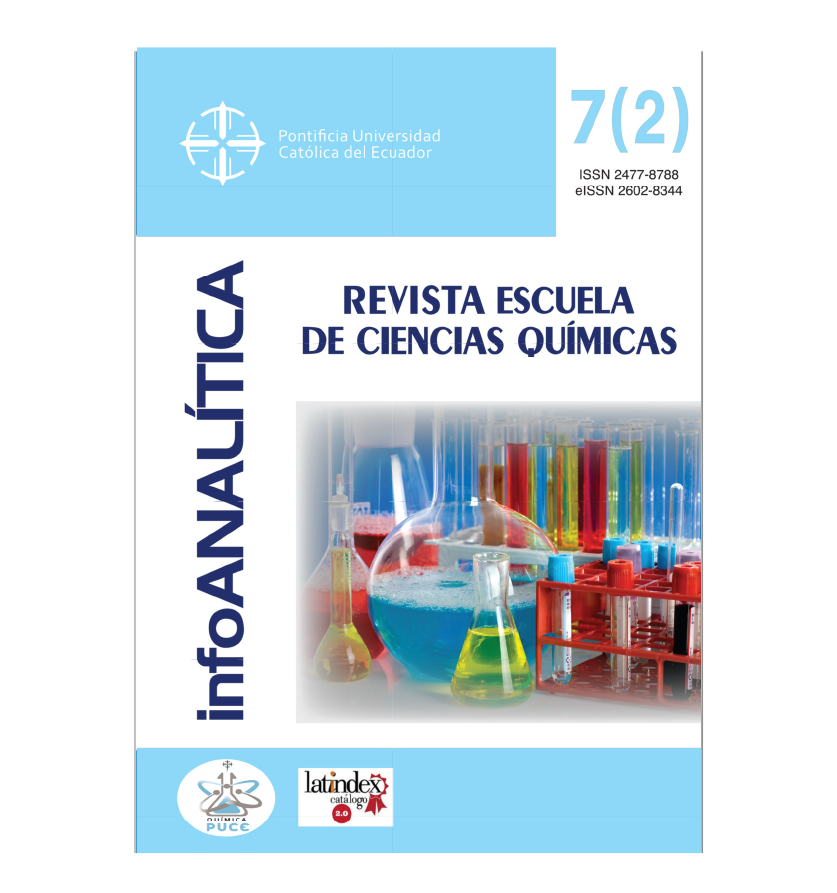Photocatalytic degradation of Aroclor 1254 using titanium dioxide irradiated with accelerated electron beam
Main Article Content
Abstract
Biphenyl polychlorides (PCB’s) are organic compounds that were used in capacitors and electrical transformers due to their insulating properties and high chemical stability. By banning the manufacture and use of PCBs, a lot of this electrical equipment became obsolete and huge volumes of dielectric oil with PCBs were stored as hazardous waste pending an alternative for their treatment. In this work, the phase transfer of PCB’s (Aroclor 1254) from the dielectric oil to an aqueous phase, for its subsequent photocatalytic degradation is proposed. Two transfer agents were probed, Polyethylene Glycol 400 and Triton X-100. The catalytic process was carried out with no irradiated TiO2 (0 kGy) and ebeam irradiated TiO2 with 20 and 60 kGy; UV-vis was used as a source of energy during photodegradation. The degradation was evaluated by gas chromatography and the mineralization was verified by Total Organic Carbon (COT). The highest phase transfer efficiency was achieved with the Triton X-100, so this agent was used in subsequent studies. The best results of degradation and mineralization of Aroclor 1254, was reached with the TiO2 irradiated at 20 kGy, these were 98.36 % and 58.92 % respectively, after 240 min of photo-oxidation. In this way this technology becomes a viable alternative to solve the problem of contamination by PCBs.
Downloads
Article Details
- The authors agree to respect the academic information of other authors, and to assign the copyrights to the journal infoANALÍTICA, so that the article can be edited, published and distributed.
- The content of the scientific articles and the publications that appear in the journal is the exclusive responsibility of their authors. The distribution of the articles published in the infoANALÍTICA Journal is done under a Creative Commons Reconocimiento-CompartirIgual 4.0 Internacional License.
References
Atmaca, E., Das, Y. K., Yavuz, O., & Aksoy, A. (2019). An evaluation of the levels of organochlorine compounds (OCPs and PCBs) in cultured freshwater and wild sea fish eggs as an exposure biomarker for environmental contamination. Environmental Science and Pollution Research, 26(7), 7005–7012. https://doi.org/10. 1007/s11356-019-04207-0
Camargo Moreno, C. E. (2014). Biotratamiento de Aceites Dieléctricos Usados (tesis de maestría). Universidad Nacional de Colombia. Obtenido de: http://bdigital.unal. edu.co/57173/7/CarlosE.CamargoMoreno.2016.pdf
Chitose, N., Ueta, S., Seino, S., & Yamamoto, T. A. (2003). Radiolysis of aqueous phenol solutions with nanoparticles. 1. Phenol degradation and TOC removal in solutions containing TiO2 induced by UV, -ray and electron beams. Chemosphere, 50(8), 1007–1013. https://doi.org/10.1016/S0045-6535(02)00642-
Cropper, W. H. (1962). Radiation Effects on the Reactivity of Solid Surfaces: Defects produced in solids by radiation fields can enter into chemical reactions on the surface. Science, 137(3534), 955–961. https://doi.org/10.1126/science.137.3534.95
Frías, M. M., & Gia, J. (2014). Descomposición del Bifenilo Policlorado (PCB) Aroclor 1260 en aceites dieléctricos, por radiólisis del agua, inducida por radiación gamma del isótopo de cobalto 60. Universidad Central Del Ecuador. Obtenido de: http://www.dspace.uce.edu.ec/handle/25000/628
Fröschl, B., Stangl, G., & Niessner, R. (1997). Combination of micellar extraction and GC-ECD for the determination of polychlorinated biphenyls (PCBs) in water. Fresenius’ Journal of Analytical Chemistry, 357(6), 743–746. https://doi.org/10.1007/ s002160050241
Habibullah-Al-Mamun, M., Ahmed, M. K., Islam, M. S., Tokumura, M., & Masunaga, S. (2019). Occurrence, distribution and possible sources of polychlorinated biphenyls (PCBs) in the surface water from the Bay of Bengal coast of Bangladesh. Ecotoxicology and environmental safety, 167, 450-458. https://doi.org/10.1016/j.ecoenv. 2018.10.052
Huang, Q., & Hong, C.-S. (2000). TiO2 photocatalytic degradation of PCBs in soil-water systems containing fluoro surfactant. Chemosphere, 41(6), 871–879. https://doi. org/10.1016/S0045-6535(99)00492-0
Izquierdo Condoy, M., & Peña Pontón, E. (2016). Diseño de sistemas de biodegradación aerobia y anaerobia a escala piloto para la descontaminación de aceites dieléctricos con bifenilos policlorados (PCB’s) (tesis de pregrado). Escuela Politécnica Nacional. Obtenido de: https://bibdigital.epn.edu.ec/handle/15000/16557
Kralchevska, R., Milanova, M., Tsvetkov, M., Dimitrov, D., & Todorovsky, D. (2012). Influence of gamma-irradiation on the photocatalytic activity of Degussa P25 TiO2. Journal of Materials Science, 47(12), 4936–4945. https://doi.org/10.1007/s10853- 012-6368-4
Law, R. J., & Jepson, P. D. (2017). Europe’s insufficient pollutant remediation. Science, 356(6334), 148.
Lopera Posada, E., & Aguire Cardona, J. (2006). Purification of mineral insulating oil contaminated with polychlorinated biphenyls (PCB’s). Dyna, 73(150), 75–88.
Nadarajan, R., Bakar, W. A. W. A., Ali, R., & Ismail, R. (2017). Method for polychlorinated biphenyls removal from mussels and its photocatalytic dechlorination. Applied Catalysis B: Environmental, 218, 327–337. https://doi.org/10.1016/j.apcatb. 2017.06.066
Parent, A. S., Pinson, A., Woods, N., Chatzi, C.,Vaaga, C. E., Bensen, A., Westbrook, G. L. (2016). Early exposure to Aroclor 1254 in vivo disrupts the functional synaptic development of newborn hippocampal granule cells. European Journal of Neuroscience, 44(12), 3001–3010. https://doi.org/10.1111/ejn.13437
Wong, K. H., Tao, S., Dawson, R., & Wong, P. K. (2004). Optimization of photocatalytic oxidation of 2,2’,3,3’- tetrachlorobiphenyl. Journal of Hazardous Materials, 109(1– 3), 149–155. https://doi.org/10.1016/j.jhazmat.2004.03.006
Xing, Y., Lu, Y., Dawson, R. W., Shi, Y., Zhang, H., Wang, T., Ren, H. (2005). A spatial temporal assessment of pollution from PCBs in China. Chemosphere, 60(6 SPEC. ISS.), 731–739. https://doi.org/10.1016/j.chemosphere.2005.05.001
Zhang, Q., Ye, S., Chen, X., Song, X., Li, L., & Huang, X. (2017). Photocatalytic degradation of ethylene using titanium dioxide nanotube arrays with Ag and reduced graphene oxide irradiated by γ-ray radiolysis. Applied Catalysis B: Environmental, 203, 673–683. https://doi.org/10.1016/j.apcatb.2016.10.034

